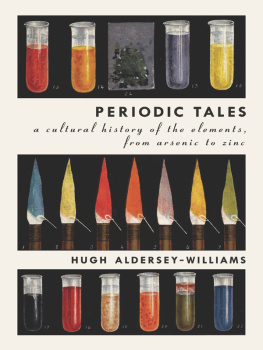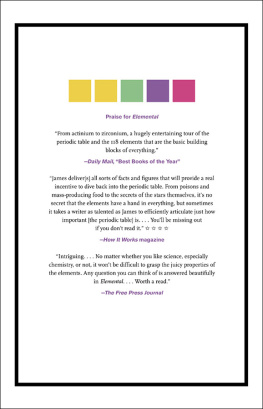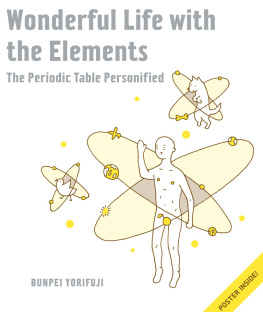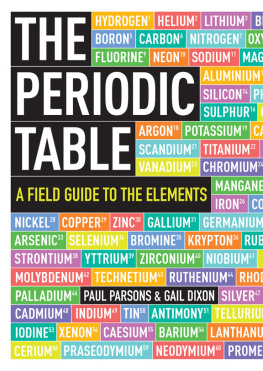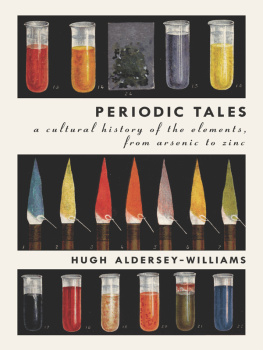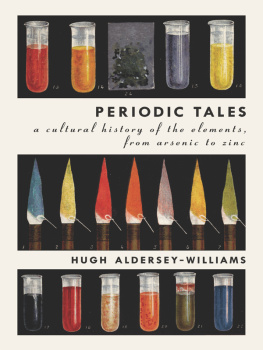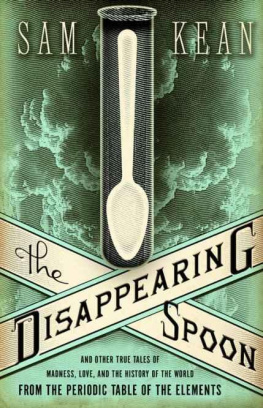Like the alphabet or the zodiac, the periodic table of the elements is one of those graphic images that seem to root themselves for ever in our memories. The one I remember is from school, hung on the wall behind the teachers desk like an altar screen, its glossy yellowing paper testament to years of chemical attack. Its an image I havent been able to shake off, despite scarcely venturing into a laboratory for years. Now I have it on my own wall.
Or at least a version of it. The familiar stepped skyline is there, and the neatly stacked boxes, one for each element. Each box contains the symbol and atomic number appropriate to the element in that position. However, all is not quite as it should be in this table. For where the name of each element should appear, there is another name entirely, one that is nothing to do with the world of science. The symbol O represents not the element oxygen but the god Orpheus; Br is not bromine but the artist Bronzino. Many of the other spaces are taken, for some reason, by figures from 1950s cinema.
This periodic table is a lithograph by the British artist Simon Patterson. Patterson is fascinated by the diagrams that are the means by which we organize our world. His way of working is to recognize the importance of the thing as an emblem of order but then to play havoc with its contents. His best-known work is a London Underground map with the stations along each line renamed after saints and explorers and football players. Strange things happen at the intersections.
It is no surprise that he should wish to play the same game with the periodic table. He has grim memories of how it was taught by rote at his school. It was convenient to teach it that way, but I could never remember it, Simon tells me. Yet he remembered the idea of it. Ten years after leaving school, he produced a series of variations on the table in which the symbol for each element kicks off a false association. Cr is not chromium but Julie Christie, Cu not copper but Tony Curtis; and then even this cryptic system is sabotaged: Ag, the symbol for silver, is not Jenny Agutter, say, or Agatha Christie, but of course Phil Silvers. There are teasing moments of apparent logic in this new tabulation: the sequential elements beryllium and boron (symbols Be and B) are the Bergmans, Ingrid and Ingmar respectively. The acting brothers Rex and Rhodes Reason appear adjacent to one another, co-opting the symbols for rhenium (Re) and osmium (Os). Kim Novak (Na; sodium) and Grace Kelly (K; potassium) share the same column in the tableboth were Hitchcock leading ladies. But in general there is no system, only the connections you make for yourself: I was tickled to see, for example, that Po, the symbol for polonium, the radioactive element discovered by Marie Curie and named by her for her native Poland, denotes instead the Polish director Roman Polanski.

I now love the ludic irreverence of this work, but my school-age self would have been quite scornful of such nonsense. While Simon was dreaming up wild new connections, I was merely absorbing the information I was meant to absorb. The elements, I understood, were the universal and fundamental ingredients of all matter. There was nothing that was not made out of elements. But the table into which the Russian chemist Dmitrii Mendeleev had sorted them was even more than the sum of these remarkable parts. It made sense of the riotous variety of the elements, placing them sequentially in rows by atomic number (that is to say, the number of protons in the nuclei of their atoms) in such a way that their chemical relatedness suddenly leapt out (this relatedness is periodic , as revealed in the alignment of the columns). Mendeleevs table seemed to have a life of its own. For me, it stood as one of the great and unquestionable systems of the world. It explained so much, it seemed so natural, that it must always have been there; it couldnt possibly be the recent invention of modern science (although it was less than a century old when I first saw it). I acknowledged its power as an icon, yet I too began to wonder in my own tentative way what it really meant. The table seemed in some funny way to belittle its own contents. With its relentless logic of sequence and similarity, it made the elements themselves, in their messy materiality, almost superfluous.
Indeed, my classroom periodic table provided no picture of what each element looked like. The realization that these ciphers had real substance struck me only at the vast illuminated table of the chemical elements they used to keep at the Science Museum in London. This table had actual specimens. In each rectangle of the already familiar grid squatted a little glass bubble beneath which a sample of the relevant element glimmered or brooded. There was no knowing whether they were all the real thing, but I noted that the curators had omitted to include many of the rare and radioactive elements, so it seemed safe to assume that the rest were authentic. Here it was vividly clear what we had been told at school: that the gaseous elements were mostly to be found in the top rows of the table; that the metals occupied the centre and left, with the heavier ones in the lower rowsthey were mostly grey, although one column, containing copper, silver and gold, provided a streak of colour; that the non-metals, more variegated in colour and texture, lay over in the top right corner.
With that, I had to start my own collection. It would not be easy. Few of the elements are found in their pure state in nature. Usually, they are chemically locked up in minerals and ores. So instead, I began to cast about the house, taking advantage of the centuries during which man has extracted them from these ores and pressed them into service. I broke open dead light bulbs and surgically snipped free the tungsten filaments, placing the wriggling wires into a little glass vial. Aluminium came from the kitchen in the form of foil, copper from the garage as electrical wire. A foreign coin that Id heard was made of nickelthough not an American nickel, which I knew was mostly copperI cut up into coarse chunks. It was worth more to me like this. It made it more, well, elemental. I discovered that my father had some gold leaf kept from his youth, when he used it for decorative lettering. I removed some of it from the drawer where it had lain in darkness for thirty years and allowed it to shine once more.
This was a definite improvement on the Science Museum. I could not only see my specimens close up, but feel whether they were warm or cold to the touch and heft them in my handa bright little ingot of tin, which I had cast in a small ceramic bath from a melted roll of solder, was astonishingly heavy. I could make them ring or rattle against the glass and appreciate their characteristic timbres. Sulphur had a primrose colour with a slight sparkle, and could be poured and spooned like caster sugar. For me, its beauty was in no way tainted by its slightly pungent odour. I have reminded myself of this smell just now, with a tin of sulphur bought from a garden shop, where it is sold to fumigate greenhouses. The dry, woody aroma is on my fingers as I type, to me not hellish as the Bible teaches, but evocative simply of childhood experimental enquiry.

